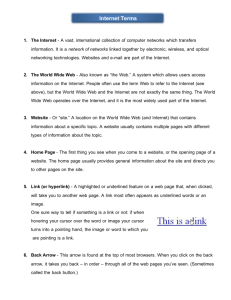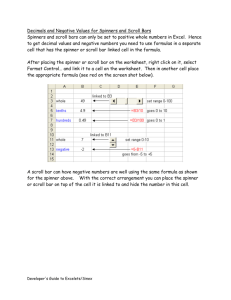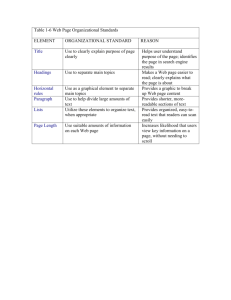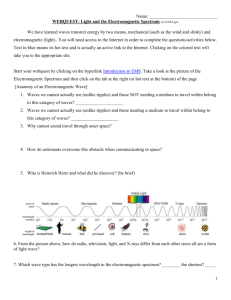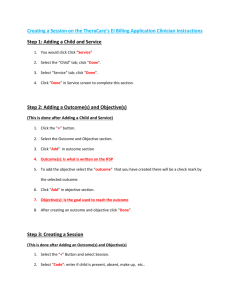Electromagnetic Spectrum Web
advertisement
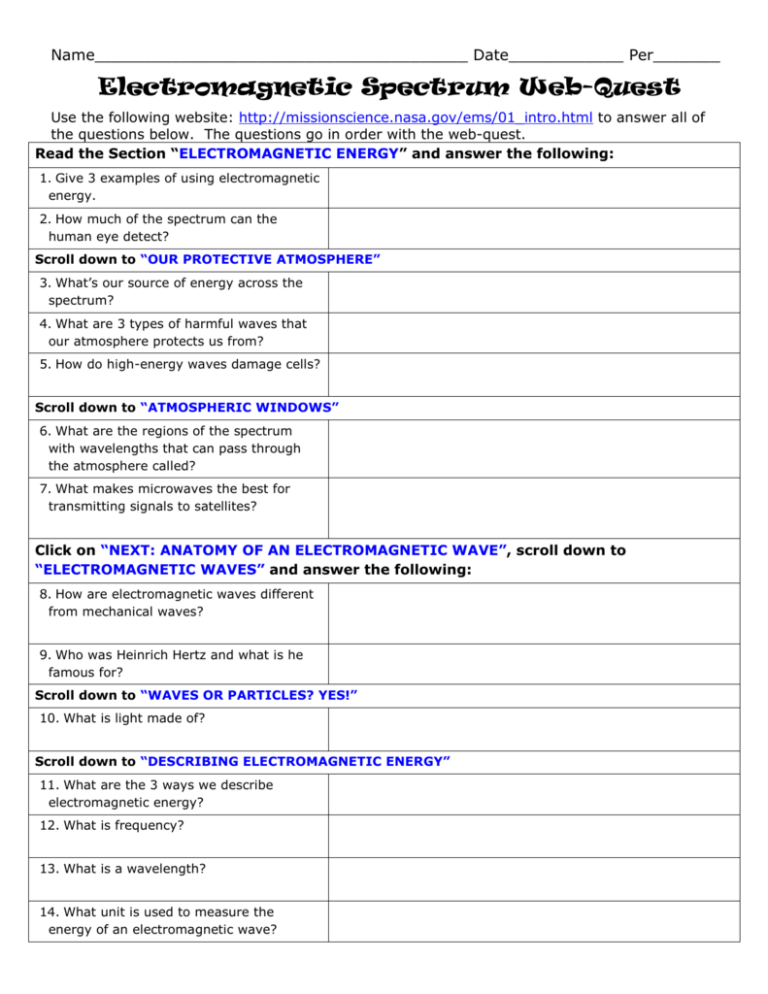
Name_______________________________________ Date____________ Per_______ Electromagnetic Spectrum Web-Quest Use the following website: http://missionscience.nasa.gov/ems/01_intro.html to answer all of the questions below. The questions go in order with the web-quest. Read the Section “ELECTROMAGNETIC ENERGY” and answer the following: 1. Give 3 examples of using electromagnetic energy. 2. How much of the spectrum can the human eye detect? Scroll down to “OUR PROTECTIVE ATMOSPHERE” 3. What’s our source of energy across the spectrum? 4. What are 3 types of harmful waves that our atmosphere protects us from? 5. How do high-energy waves damage cells? Scroll down to “ATMOSPHERIC WINDOWS” 6. What are the regions of the spectrum with wavelengths that can pass through the atmosphere called? 7. What makes microwaves the best for transmitting signals to satellites? Click on “NEXT: ANATOMY OF AN ELECTROMAGNETIC WAVE”, scroll down to “ELECTROMAGNETIC WAVES” and answer the following: 8. How are electromagnetic waves different from mechanical waves? 9. Who was Heinrich Hertz and what is he famous for? Scroll down to “WAVES OR PARTICLES? YES!” 10. What is light made of? Scroll down to “DESCRIBING ELECTROMAGNETIC ENERGY” 11. What are the 3 ways we describe electromagnetic energy? 12. What is frequency? 13. What is a wavelength? 14. What unit is used to measure the energy of an electromagnetic wave? Click on “NEXT: WAVE BEHAVIORS” and answer the following: 15. What happens when light encounters an object? Scroll to the bottom, click on “NEXT: FROM ENERGY TO IMAGE”, then scroll to the bottom AGAIN, click on “NEXT: RADIO WAVES” and answer the following: 16. What is the range in length for radio waves? 17. How do radios work? Scroll down to “RADIO TELESCOPES” 18. How do radio telescopes work? Scroll down to “A VERY LARGE TELESCOPE” 19. How do astronomers make clearer images from radio telescopes? Scroll down to “THE RADIO SKY” 20. What can radio telescopes also detect? Click on “NEXT: MICROWAVES” and answer the following: 21. How do microwaves cook food? Scroll down the “CLUES TO THE BIG BANG” 22. What discovery was made in 1965 by scientists at Bell Labs? Click on “NEXT: Infrared Waves” and answer the following: 23. Look at the scale at the top of the page: what’s the relative size of infrared waves? Scroll down to “THERMAL IMAGING” 24. What 2 instruments allow us to “see” infrared waves? Scroll down to “SEEING THROUGH THE DUST” 25. How do infrared waves allow us to better observe new stars in nebulas? Scroll to the bottom, click on “NEXT: Reflected Near-Infrared Waves”, then scroll to the bottom AGAIN, click on “NEXT: VISIBLE LIGHT” and answer the following: 26. What color of visible light has the longest wavelength? 27. What color of visible light has the shortest wavelength? Scroll down to “COLOR AND TEMPERATURE” 28. What color light does the sun produce? 29. What color would it be if it were cooler? 30. What color would it be if it were hotter? Scroll to the bottom, click on “NEXT: ULTRAVIOLET” and answer the following: 31. What animals can see UV radiation? 32. What type of UV rays cause sunburns? 33. What layer of the atmosphere blocks 95% of UV-B rays? Scroll to the bottom, click on “NEXT: X-RAYS” and answer the following: 34. What’s the relative size of X-rays? Scroll down to “DISCOVERY OF X-RAYS” 35. Why do bones show up on X-Rays? 36. What part of the Sun do scientists use X-rays to study? Scroll down to “SUPERNOVA” 37. Where do telescopes with X-ray detectors have to be positioned? 38. How are X-rays used to study supernova remnants like Cassiopeia A? Scroll to the bottom, click on “NEXT: GAMMA RAYS” and answer the following: 39. What’s the relative size of Gamma rays? 40. What do gamma rays have more of than any other type of wave? 41. What types of objects in the universe produce gamma rays? 42. How can gamma waves be generated on Earth? Scroll down to “GAMMA RAY BURSTS” 43. What is a Gamma Ray Burst and how much energy can it release? 44. What’s one of the most distant objects ever detected by NASA’s swift satellite? Scroll down to “COMPOSITION OF PLANETS” 45. How are gamma rays used to study other planets?
